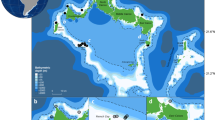Summary
Ligia oceanica can change its colour using melanophores, the animal's reflectance varying between about 2 and 10%. Darker individuals heat up more quickly, and to higher body temperatures, than do pale ones. Colour change shows an underlying circadian rhythm, though the pattern of this rhythm varies with temperature, humidity, background and time of year. In general the rhythm is such as to ensure maximum camouflage at the critical dusk period, but in some conditions hygrothermal needs are overriding and the animals are paler (to stay cool) or darker (to warm up). In addition, animals show short term colour modification; when transferred to differing backgrounds and temperatures their colours initially reflect background matching, but after 30–45 min are modified into thermally appropriate shades, dark at 5° C and pale at 20° C. Field-caught specimens showed body temperatures that varied with colouration, and modification of colour in relation to thermal needs, particularly by being paler than expected when forced into the open by daytime high tides, and darker than expected when active prior to dusk. Animals invariably selected dark backgrounds in choice chambers. However, choice of humidity depended on previous experience; saturated air was normally preferred, but warm animals chose drier air (to allow evaporative cooling) unless also water-stressed. They also tended to disperse to facilitate cooling, whereas aggregation increased with increasing RH and with decreasing temperature. The interactions of colour changes, behavioural choices, and activity patterns in controlling the hygrothermal belance of Ligia in the intertidal environment are discussed in the light of these results.
Similar content being viewed by others
References
Allee WC (1926) Studies in animal aggregation: causes and effects of bunching in land isopods. J Exp Zool 45:255–277
Armitage KB (1960) Chromatophore behaviour of the isopod Ligia occidentalis. Crustaceana 1:193–207
Brock MA (1974) Circannual clocks in invertebrates. In: Pengelley ET (ed) Circannual Clocks. Academic Press, New York, pp 11–53
Digby PSB (1955) Factors affecting the temperature of insects in sunshine. J Exp Biol 32:279–298
Edney EB (1951) The evaporation of water from woodlice and the millipede Glomeris. J Exp Biol 28:91–115
Edney EB (1953) The temperature of woodlice in the sun. J Exp Biol 30:331–349
Edney EB (1954) Woodlice and the land habitat.Biol Rev 29:185–219
Edney EB (1967) Water balance in desert arthropods. Science 156:1059–1066
Enami M (1941) Melanophore response in an isopod crustacean, Ligia exotica. I. General responses. Jap J Zool 9:497–515
Fingerman M (1956) The physiology of the melanophores of the isopod Ligia exotica. Tulane Stud Zool 3:137–148
Fingerman M (1963) The Control of Chromatophores. Pergamon Press, Oxford
Fingerman M (1985) The physiology and pharmacology of crustacean chromatophores. Am Zool 25:233–252
Friedlander CP (1965) Aggregation in Oniscus asellus Linn. Anim Behav 13:342–346
Hamilton WJ (1973) Life's Colour Code. McGraw Hill, New York
Hogben LT, Slome D (1931) The pigmentary effector system. VI. The dual character of endocrine coordination in amphibian colour change. Proc Roy Soc B 108:10–53
Kleinholz LH (1937) Studies in the pigmentary system of Crustacea. I. Colour changes and diurnal rhythms in Ligia baudiniana. Biol Bull 72:24–36
Kleitman M (1940) The modifiability of the diurnal pigmentary rhythm of isopods. Biol Bull 78:403–406
Miller MA (1938) Comparative ecological studies on the terrestrial isopod Crustacea of the San Francisco Bay region. Univ Calif Publ Zool 43:113–142
Needham AE (1974) The Significance of Zoochromes. Springer, Berlin Heidelberg New York
Nicolaus RA (1968) Melanins. Hermann et Cie, Paris
Palmer JD (1976) An Introduction to Biological Rhythms. Academic Press, London
Parry G (1953) Osmotic and ionic regulation in the isopod crustacean Ligia oceanica. J Exp Biol 30:567–574
Pertunnen V (1961) Reaction de Ligia italica F. à la lumiere et à l'humiditie de l'air. Vie et Milieu 12:219–259
Sawaya P (1937) Sobre a mudanca da cor nos Crustaceos. Biol Fac Filos Cie Let Univ Sao Paulo Zoologia 13:1–109
Smith HG (1938) The receptive mechanism of the background response in chromatic behaviour of Crustacea. Proc Roy Soc B 125:250–263
Solomon ME (1951) Control of humidity with potassium hydroxide, sulphuric acid and other solutions. Bull Entomol Res 42:543–554
Spencer JD, Edney EB (1954) The absorption of water by woodlice. J Exp Biol 31:491–496
Stevenson RD (1985) The relative importance of behavioural and physiological adjustments controlling body temperature in terrestrial ectotherms. Am Nat 126:362–386
Takeda N (1984) The aggregation phenomenon in terrestrial isopods. Symp Zool Soc London 53:381–404
Unwin DM (1980) Microlimate Measurement for Ecologists. Academic Press, London
Wieser W (1984) Ecophysiological adaptations of terrestrial isopods: a brief review. Symp Zool Soc London 53:247–265
Willmer PG, Unwin DM (1981) Field analysis of insect heat budgets; reflectance, size and heating rates. Oecologia 50:250–255
Author information
Authors and Affiliations
Rights and permissions
About this article
Cite this article
Willmer, P.G., Baylis, M. & Simpson, C.L. The roles of colour change and behaviour in the hygrothermal balance of a littoral isopod, Ligia oceanica . Oecologia 78, 349–356 (1989). https://doi.org/10.1007/BF00379108
Received:
Issue Date:
DOI: https://doi.org/10.1007/BF00379108




